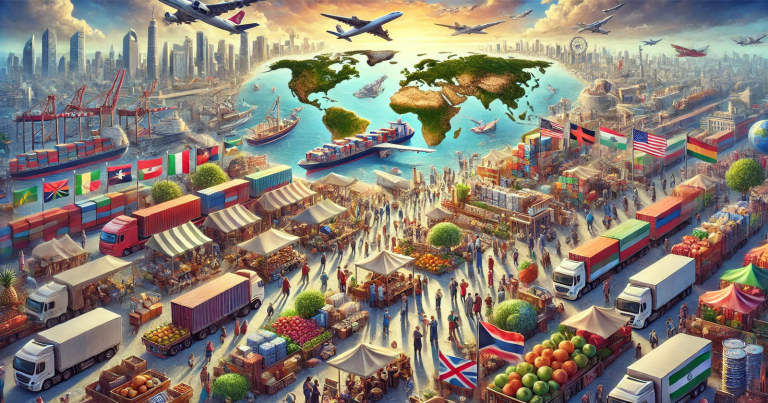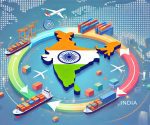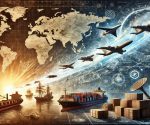In economics, trade is essential in bridging the world’s economies. This helps a country import products they are not able to manufacture within the borders. In theory, the core idea behind the concept of trade is that people should specialise in what they produce best, trade, and import goods from others for needs they cannot manufacture locally. Whether internal trade within one country or international trade across borders, the exchange of goods and services has been fundamental in shaping economic development throughout history.
To understand what is trade in economics in the modern world, one has to understand the exchange but a powerful tool that drives economic growth, encourages innovation, and creates global markets for businesses. However, trade also brings challenges such as job displacement, trade imbalances, and environmental concerns, which must be carefully managed to maximise the benefits of trade while minimising its negative impacts.
What is Trade in Economics?
In economics, trade refers to the process of trading between parties and involves exchanging various goods and services, which in most cases happens between countries and different regions. Domestic or international, trading between parties is getting what is lacking at a specific locality and supplying whatever the person, company, or country produces. Therefore, it allows people, firms, and governments to gain advantages from items or resources not possessed.
International Trade refers to importing and exporting goods and services across borders. This enables countries to specialise in what they produce most efficiently, thus promoting economic growth and global wealth. Therefore, trade forms an essential element of international economic activity, which affects everything from market prices to the availability of goods and services.
Types of Trade
When discussing economics trade, it is very important to understand the different trade types. Generally, trade can be categorised into two major types: Domestic and International. Each type involves unique mechanisms and plays an essential role in the economy. Let’s dive deeper into both types.
Domestic Trade
Domestic trade is the exchange of goods and services within a country. It can be between individuals, organisations, or even states and provinces. Domestic trade typically is more straightforward because it does not contend with the issues of foreign border crossing, tariffs, or other foreign currency issues.
In domestic trade, normally, there are three main types:
- Wholesale Trade: It sells goods in large quantities, usually from producers to retailers or wholesalers.
- Retail Trade: This is selling goods directly to consumers in smaller quantities.
International Trade
International trade involves the exchange of goods and services between various countries. This kind of trade is the basis of globalisation and helps connect the markets of the globe. International trade allows countries to specialise in producing some goods or services and trade for others, maximising efficiency and promoting economic growth.
- Tariffs and Duties: Countries could also impose duties on imports and exports, thus raising the price of trade.
- Exchange Rates: Countries also have different currencies that trade partners use and have to negotiate their values as these fluctuate.
- Trade Agreements: There are trade agreements, such as NAFTA or the EU, under which countries undertake agreements to decrease the barriers between their trade practices and promote better exchanges.
Theories of Trade in Economics
Economists have developed several theories that explain how trade works and why countries engage in it. These theories are of immense value for understanding the motivation for trade and its impact on the world economy.
Absolute Advantage Theory
According to Adam Smith, a country should specialise in producing goods that it can make more cheaply than others. Countries then trade with one another to get goods they cannot produce as cheaply so that global welfare is maximised.
Comparative Advantage
This theory was first proposed by David Ricardo, who states that even if a country has no absolute advantage in producing any good, it can still benefit from trade by specialising in producing goods with the least disadvantage. This concept has become one of the most essential concepts in international trade, which shows that trade can be beneficial even when one country is less efficient than others in all goods.
Heckscher-Ohlin Model
A country would export factors in which it has abundance and import those in which it has scarcity. For instance, countries abundant in capital are more likely to export technological products, and countries abundant in labour have a high propensity to export textile products.
New Trade Theory
New Trade Theory introduces economies of scale and network effects. It supports the idea that countries can focus on specific production areas despite not having any comparative advantage for such products because large-scale production reduces costs. This causes firms to concentrate in particular regions or sectors, making trade efficient.
How Trade Works?
Knowledge of how trade works requires analysis of the procedures followed in exchanging goods and services. Economic policies and natural factors determine Trade as a dynamic and multifaceted activity.
- Production: Production starts when the country or the business produces goods or services demanded either in its domestic market or in the world market.
- Pricing and Marketing: The goods are priced considering the supply and demand. For exporters, the price strategy has to be changed, and the product must look attractive in overseas markets.
- Logistics and Transportation: As soon as the price is determined, goods must be transported across borders. This includes shipping, air freight, customs clearances, and distribution networks.
- Customs and Regulations: Once the goods reach the foreign country, they follow local regulations, such as tariffs, taxes, and other customs requirements.
- Consumption and Distribution: As soon as the goods are cleared from customs, they reach the local markets, where consumers or businesses can buy them.
What Facilitates Trade?
Several factors facilitate trade and enable it to thrive. These include infrastructure, policies, and international agreements that reduce trade barriers. Now, let us break down a few key elements that help facilitate trade. Infrastructure includes transport systems, highways, and airports.
- Trade Agreements: Free trade areas or customs unions reduce tariffs, quotas, and other barriers to international trade. These agreements make trade more predictable and cost-effective.
- Government Policies: The government can establish good conditions through policy reforms to encourage trade. These include tax cuts on exports, subsidies on domestic industries, or reducing import restrictions.
- Technology: Technology greatly facilitates the trade process since it makes the whole process easier. Communications, logistics, and finance technological advancement enable companies to trade across borders cheaply and even speed up the trade.
- Financial Systems: In international trade, money is also required for manufacturing, shipping, and insurance over a long period. Efficient finance and money transfer systems lighten the burden and reduce risks associated with international trade transactions.
Advantages and Disadvantages of Trade in Economics
Trade is a critical component in the world’s economy as it creates room for development and prosperity in both countries and companies. Through trade, a government will obtain products and services that cannot be developed in their economies; hence, more economic activities take place.
Advantages of trade
International and domestic trade exchanges have various advantages for countries. Specialisation in certain goods for production enhances efficiency, but importing certain goods not produced with the same efficiency enhances economic growth while allowing access to various goods. International trade inspires innovation, enhanced competition, and businesses expanding their markets, though the adverse effects also require balancing.
Disadvantages of Trade
Despite its vast benefits, trade has its own set of challenges. For example, specific industries are outcompeted by cheap foreign products and thus suffer from loss of employment and production in that particular sector. In addition, a country may suffer trade imbalances as it imports more than it exports. Environmental degradation and cultural erosion are other drawbacks associated with the growth of international trade. These adverse effects must be considered for trade benefits to reach more people.
| Advantages of Trade | Disadvantages of Trade |
| Increased Market Access: Businesses can expand their market reach beyond domestic borders. | Job Losses in Certain Industries: Some local industries may suffer from foreign competition. |
| Specialization: Countries can focus on producing goods they are most efficient at making. | Trade Imbalances: A country may end up importing more than it exports, leading to a trade deficit. |
| Economic Growth: Trade stimulates economic growth by allowing nations to access more resources and technology. | Cultural Erosion: Overreliance on foreign products may diminish local cultures and traditions. |
| Enhanced Product Variety: Consumers have access to a wider range of goods and services. | Environmental Concerns: Increased trade can lead to more transportation, contributing to pollution. |
What Is Trade In Economics? FAQs
What is Trade Deficit in Economics?
A trade deficit is when a country imports more goods and services than it exports.
What is Trade Cycle in Economics?
The trade cycle refers to fluctuations in economic activities over time. It includes phases of expansion, peak, recession, and recovery in trade, as well as the economic output.
What is Foreign Trade’s Role in Economic Development?
Foreign trade plays a very important role in economic development since it opens up a country’s source of resources, technologies, and markets beyond their domestic setups.
What is Balance of Trade in Economics?
The balance of trade is the difference between a country’s exports and imports, measured in terms of value.
What is Trade Liberalization?
Trade liberalization is the removal of trade barriers, such as tariffs, quotas, and regulations, in order to facilitate free movement of goods and services across borders.


